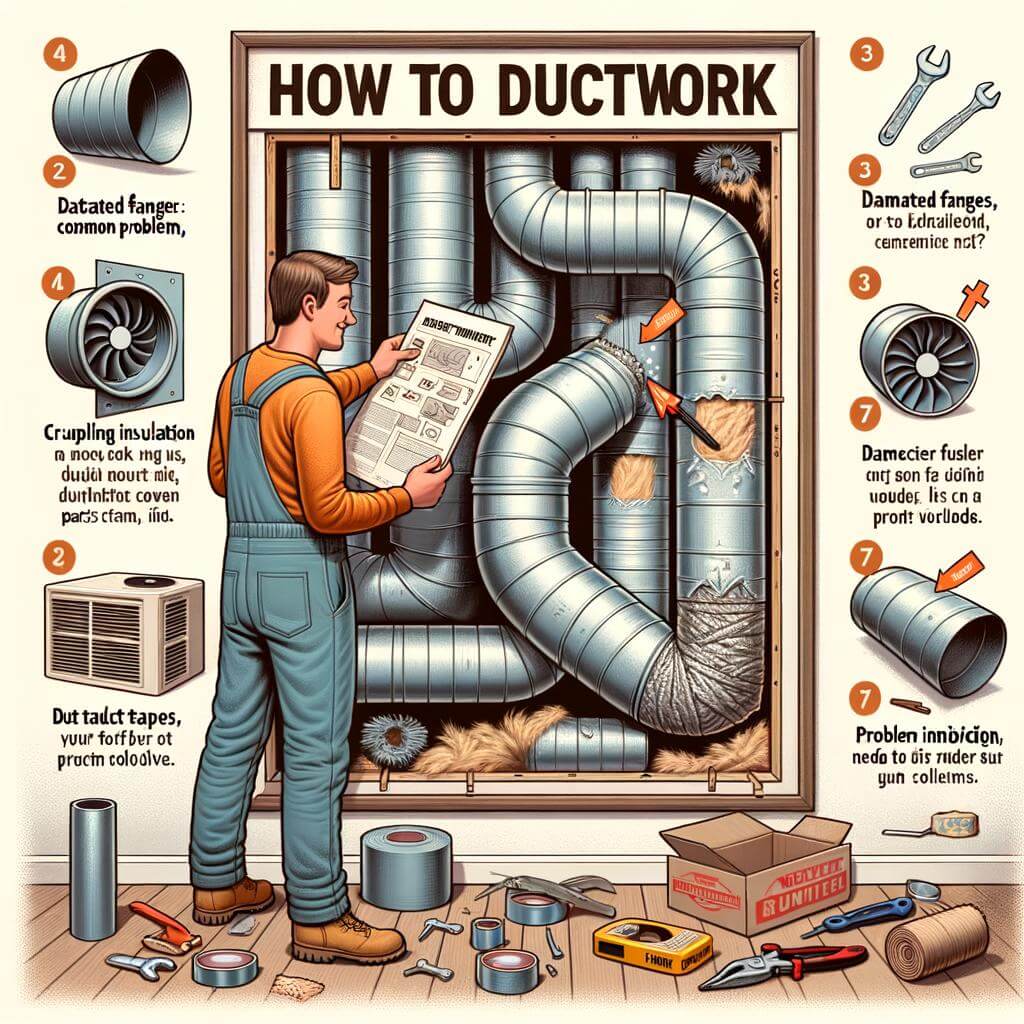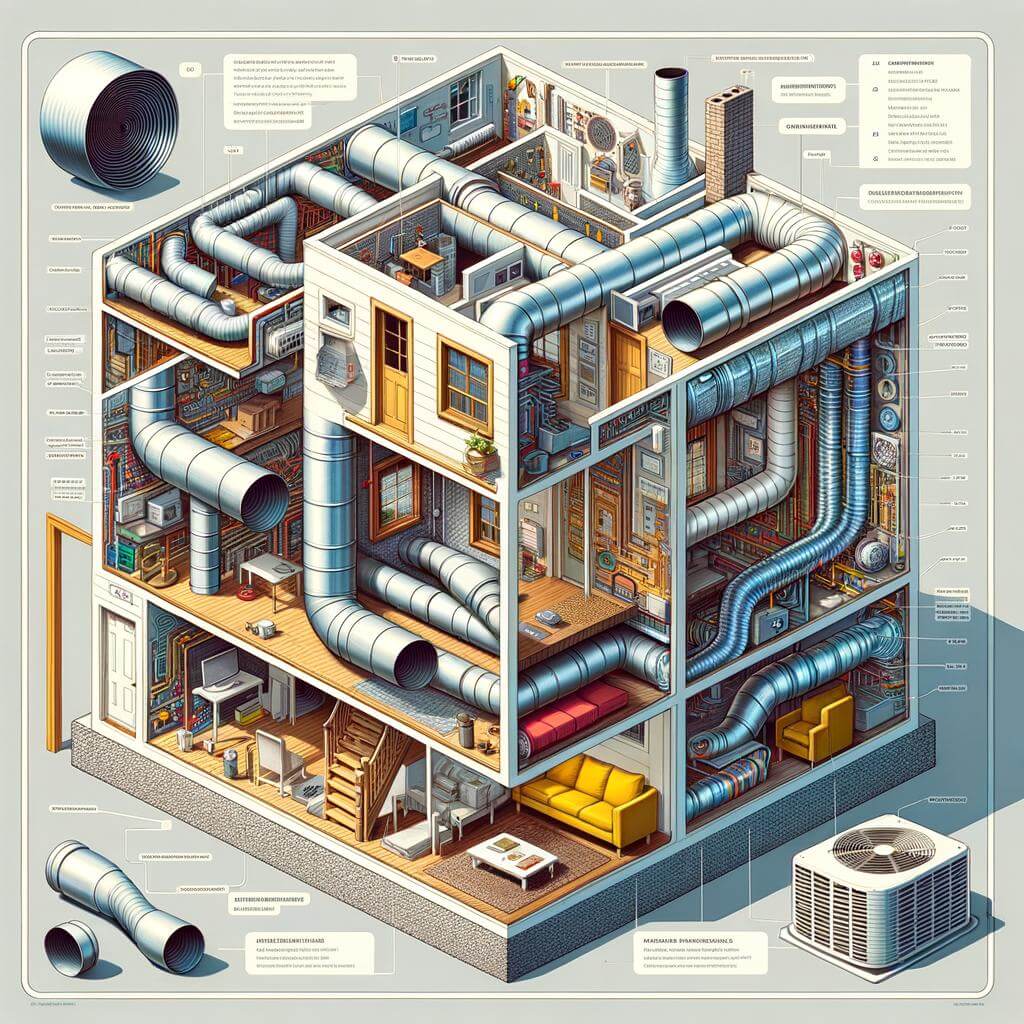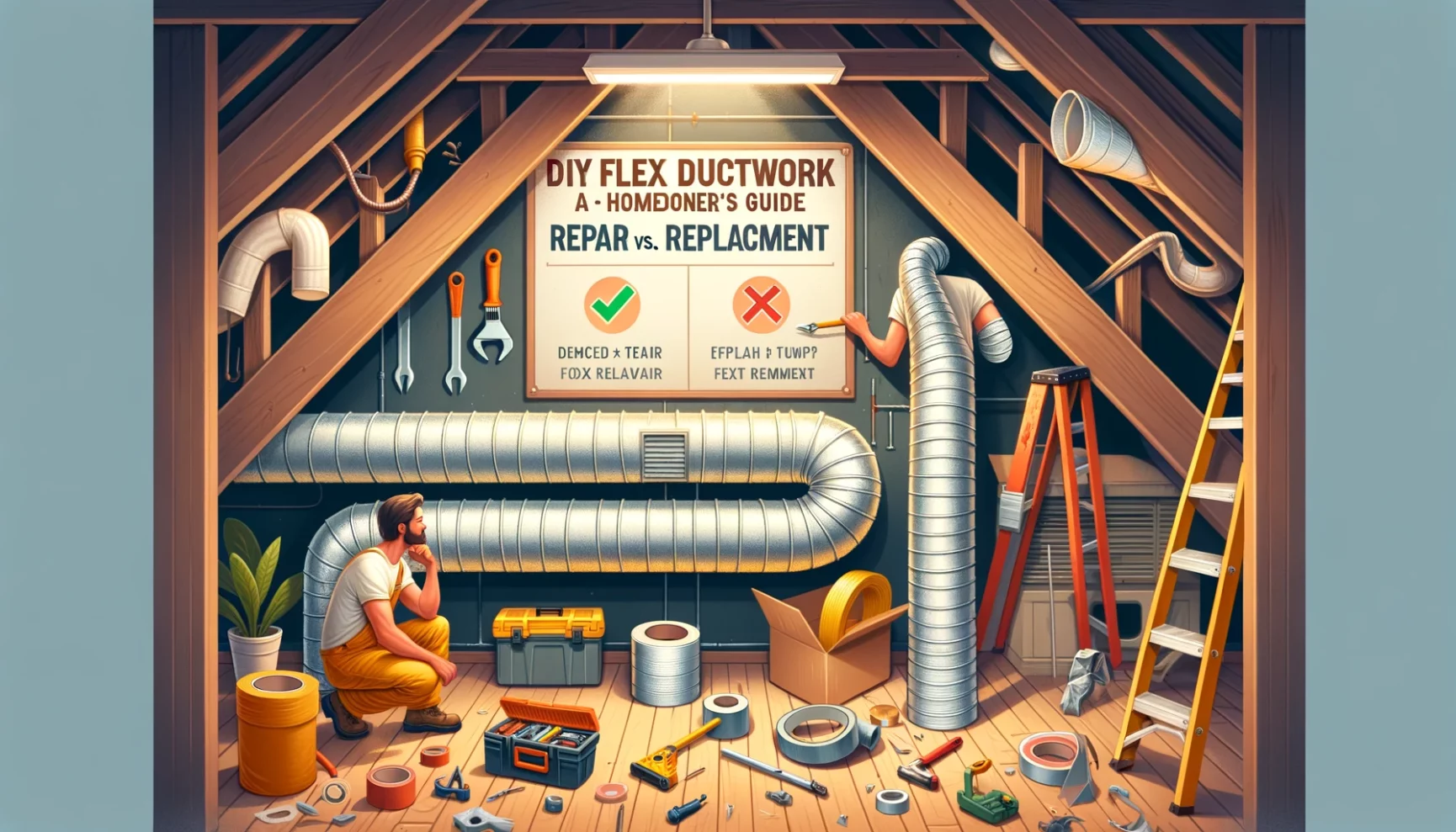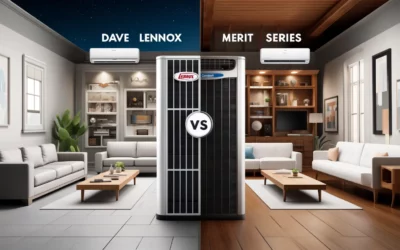Welcome to our comprehensive guide “DIY Flex Ductwork Repair vs. Replacement: A Homeowner’s Guide”. This post is crafted especially for homeowners who desire to gain practical, expert insight into the world of flex ductwork maintenance. This guide will help you understand whether your flex ductwork needs simple repairs or a complete replacement, providing you with the knowledge to make informed decisions and potentially save substantial time and money. We delve into the nitty-gritty of ductwork problems, solutions, associated costs and how to perform basic repairs yourself. By imparting you with expert advice and fact-based information, we aim to make your DIY flex ductwork repair or replacement journey smoother and hassle-free. So whether you’re handy with home maintenance or a complete beginner, this guide has something valuable for you!

Understanding the Basics: What is Flex Ductwork
In the realm of HVAC systems, flex ductwork holds a critical position. It consists of a bendable, yet robust, type of piping that is designed to transport conditioned air throughout your home. The main component is a flexible plastic covering over a metal wire coil to form a tube. Its flexibility allows it to conveniently route around obstacles, such as structural beams and corners. That’s why it’s commonly used for feeding air supply to individual vents.
When considering whether to repair or replace flex ductwork, it can be helpful understanding its anatomy. At its core, flex duct consists of three main components:
- The Inner Lining: Acts as the pathway for air to travel. It’s typically made of lightweight plastic.
- The Insulation Layer: Seals in the cold or hot air traveling through the duct, minimizing energy loss.
- The Protective Outer Jacket: Provides a defend against damage like tears and abrasions. Usually, it’s made of a durable plastic or metalized foil.
Knowing these basics can be hugely beneficial when assessing the state of your ductwork and deciding whether a DIY repair or a professional replacement is the most appropriate option. In the next section, we will delve into various diagnostic techniques to determine the condition of your flex ductwork.
Note: Always remember that either diagnosis or repair of HVAC systems can cause potential issues or damages and should be performed with caution and proper safety measures.
Recognizing the Signs: When Does Your Ductwork Need Repair
When it comes to your home’s comfort and energy efficiency, the condition of your ductwork plays a significant role. Recognizing the signs of necessary ductwork repair can save you from costly energy bills and potential damages. Increased energy bills, uneven heating or cooling throughout your home, and strange noises emanating from your ducts are all red flags indicating a potential problem.
In some extreme cases, the duct may be damaged beyond repair requiring replacement. Key signs that a replacement is required include: serious infestations of insects or rodents, significant mold growth, and persistent offensive odors. With these symptoms, although more expensive upfront, replacement will likely be more cost-effective in the long run. However, deciding whether to repair or replace your ductwork can be challenging.
- If your ducts are relatively new and the damage is minor, repair may suffice.
- On the other hand, if the ducts are older, there’s significant damage, or you frequently need repairs, replacement might be a smarter move.
| Consideration | Repair | Replacement |
|---|---|---|
| Cost | Lower upfront costs | Higher upfront costs but potential long-term savings |
| Extent of Damage | Suitable for minor damages | Recommended for severe damages |
| Age of Ductwork | Works best for newer ducts | Ideal for older, frequently repaired ducts |
Remember, whether you decide on repair or replacement, professional guidance can be invaluable. Experts not only have the necessary equipment but also the skills to accomplish the job efficiently and safely. DIY is only recommended for minor fixes.

DIY Ductwork Repair: A Step-by-Step Guide for Homeowners
Every homeowner knows that proper heating and cooling efficiency directly depends on the state of your HVAC ductwork. Even a small leak or damage can significantly increase your energy bills and decrease your system’s efficiency. That’s why knowing how to repair ductwork becomes a crucial skill. However, when it comes to Flex ducts, which are typically made from plastic over spiral wire, the decision between repairing and replacing becomes a bit tricky.
Generally, if your duct damage is minor, a DYI ductwork repair might be the right solution. Here’s a brief breakdown of how to do it:
- Identify the location of the leak or damage
- Turn off your HVAC system to avoid further damage
- Seal the leak using mastic or metal tape (Note: Regular duct tape tends not to hold up)
- Re-insulate the flex duct once the sealant is fully dried
On the other hand, if your duct has extensive damages or it’s very old without performing well, full replacement might be your best bet. Here are the steps:
- Determine the right size and type of new flex duct you need
- Remove the old, damaged flex duct
- Install new flex duct and secure it well
- Seal your connections with mastic or metal tape
| Situation | Option |
|---|---|
| Minor leak/damage | Repair |
| Old or extensive damage | Replacement |
In conclusion, whether to repair or replace your flex duct ultimately depends on the severity of the damage and the age of your system. Always remember, when in doubt, call a professional!
Weighing the Pros and Cons: DIY Repair vs Professional Replacement
There’s no denying the satisfaction that comes with a successful DIY flex ductwork repair. It’s a cost-effective approach that grants a sense of self-accomplishment. When embarking on a do-it-yourself project, you save on the labour costs that could have been incurred if a professional was hired. Also, you have the chance to buy your desired parts depending on your preferred quality and price range. Plus, the knowledge and experience gained can be useful for future related household issues.
On the flip side, DIY repairs also carry inherent risks. One major concern is that improper handling or botching could cause further damage to the ductwork system – leading to additional costs in the long run. Then, there’s the issue of warranty. Most HVAC systems come with warranties which stipulate that DIY attempts may void the warranty. Now, think also about the time and effort required - these factors can be overlooked, but they are significant considerations to bear in mind.
| DIY Repair | Professional Replacement |
|---|---|
| Cost Effective | Potentially More Expensive |
| Risk of Further Damage | Guaranteed Quality |
| Uses Personal Time and Effort | Convenient with Expert Assistance |
When it comes to professional replacement, the perks revolve around expertise, convenience, and guarantees. HVAC professionals are trained to diagnose and remedy any issues with efficiency and precision. They will likely complete the job faster and more accurately than a homeowner tackling the task for the first time. Plus, they safeguard your home’s warranty and typically offer a guarantee on their work.
However, it’s essential to note that these benefits come with a higher price tag. The labor and parts alone can add up, making professional replacement the more expensive route compared to DIY repairs. Therefore, homeowners must evaluate their budget, expertise, and the condition of the ductwork before deciding the best course of action.
Factors to Consider: Cost, Time, and Efficiency in Ductwork Repair and Replacement
The first crucial factor to consider when deciding between repair and replacement of flex ductwork is cost. Repairing a damaged flex duct can be cheaper in the immediate term, but if the ductwork is old or significantly damaged, it could lead to further problems and extra costs down the line. Conversely, replacing the entire ductwork can be a high upfront expense, but could save you money in the long term by preventing possible recurrent repairs. Additionally, replacement might be the more cost-effective option if your ductwork is poorly installed or inefficient, leading to wasted energy and inflated utility costs.
| Action | Short-term cost | Long-term cost |
|---|---|---|
| Repair | Lower | Can be higher if repeated repairs are needed |
| Replacement | High | Can be lower due to increased efficiency and prevention of future damage |
The second important consideration is time and efficiency. A simple repair job might only take a few hours, while replacing entire sections of ductwork could necessitate a much more substantial time investment. The timing of the job could also influence your decision – if it’s mid-winter and your ductwork is leaking heat, you might opt for a quick repair solution rather than living without a heating system while you wait for a full replacement. As for efficiency, consider not only how quickly the job can be done, but how effective each solution is. A quality repair can prolong the life of your ductwork, but a full replacement might increase the overall efficiency of your HVAC system, saving you time and money in the long-run.
- Repair: Usually faster but may have lower efficiency.
- Replacement: Time-consuming but generally provides optimal efficiency and long-term cost benefits.

Final Thoughts: Making an Informed Decision on Your Ductwork Needs
Deciding between repair or replacement of your ductwork doesn’t have to be complicated. The key is to make an informed decision based on your individual needs. Consider factors such as the age, condition, and efficiency of your existing ductwork. Over time, ductwork can develop leaks, which significantly impact the overall efficiency of your heating and cooling system. If your ductwork is relatively new and the issue is minimal, repairing could be a practical solution.
On the other hand, if your ductwork is old and severely damaged, replacement might be the wiser option. By replacing the ductwork, you can improve the efficiency of your HVAC system and ensure a healthier and more comfortable living environment. Here is a simple table to help you weigh the pros and cons:
| Options | Pros | Cons |
|---|---|---|
| Repair | Cost-effective for minimal damages, Quick solution | Temporary fix, May not improve the efficiency |
| Replacement | Improves efficiency, Long-term solution | Expensive, Time-consuming |
Remember, the choice between DIY flex ductwork repair and replacement heavily depends on your particular circumstance and the severity of the ductwork damage. Equipped with this knowledge, you can make an informed decision and ensure that your home’s heating and cooling system remains efficient and reliable for years to come.
Final Thoughts
In conclusion, factors such as cost, time, experience, and the condition of your flex ductwork play a significant role in deciding whether to repair it or opt for a replacement. While DIY can be a rewarding and cost-effective option, it requires careful consideration and proper skills to ensure the tasks are carried out effectively. It’s crucial to remember that if the damage is beyond simple repair, replacement becomes inevitable. This efficient guide equips homeowners with handy tips and an in-depth understanding of various aspects of DIY flex ductwork repair and replacement. Always remember, don’t hesitate to seek professional help when needed to ensure safety and durability. After all, having proper ductwork is an essential part of creating a comfortable and energy-efficient home.









